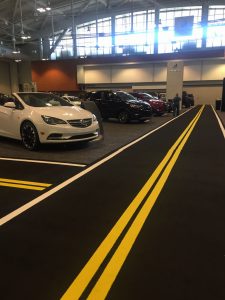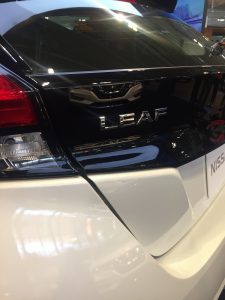
Trends From the Nashville International Auto Show
 Nashville–While Nashville is undoubtedly a smaller city than Manhattan or Los Angeles, it sits in a prime location to showcase new vehicles and promote back models. Behind the healthcare sector, the auto industry is the second largest the state has to offer, with major manufacturing plants from GM, Volkswagen, and Nissan. In fact, the Nissan plant in Smyrna is one of the most productive manufacturing plants in North America and there are less than ten counties in the state of Tennessee that don’t house some automotive operation.
Nashville–While Nashville is undoubtedly a smaller city than Manhattan or Los Angeles, it sits in a prime location to showcase new vehicles and promote back models. Behind the healthcare sector, the auto industry is the second largest the state has to offer, with major manufacturing plants from GM, Volkswagen, and Nissan. In fact, the Nissan plant in Smyrna is one of the most productive manufacturing plants in North America and there are less than ten counties in the state of Tennessee that don’t house some automotive operation.
The car industry may be a large part of life for the folks out this way, but the presentation from automakers and industry professionals was soft, if enjoyable. Unlike larger events of its ilk, the Nashville International Auto Show was housed in one room of the Music City Convention Center, with test driving options to take enthusiasts around the city. The smaller event did provide more opportunity to interact with each vehicle and speak with representatives, however, and here are a few key takeaways from the show.
Style is…Back in Style
Back in April, at the New York City International Auto Show, we got the opportunity to enjoy the styling on the 2019 Toyota Camry, a car long appreciated for its reliability and dependability, but one that has never been known for panache, design or chic. Until this year. And it appears that the trend toward more aerodynamic aesthetic–if not effect–is picking up speed in mid-sized sedans and SUV/crossovers alike.
To which we say – carry on! While the powerful muscle cars and sports cars of the performance divisions have broken free of the chains of anemic styling and bulbous designs, truly utilitarian vehicles have lagged behind in such advances. Hopefully, we will continue to see more unnecessary spoilers, swoopy vents, and angry grilles.
The Crossover is King, Queen, and Confidante
 While there was an undeniable push toward more stylish sedans, there were also fewer sedans overall. Crossovers–and whatever your definition of them may be–have taken the industry by storm at both a production and consumer level. Each car company defines crossover differently, and many use crossover as a substitute for the tarnished SUV moniker, so the ubiquity could largely be attributed to an unrefined classification system. But not entirely. Whether crossovers were amalgams of wagons, SUVs, sedans, trucks or anything in-between, there were more of them on the showroom floor than we’ve seen at any event in years past. The deciding lines between cars, trucks, and SUVs are no longer as clear as they once were.
While there was an undeniable push toward more stylish sedans, there were also fewer sedans overall. Crossovers–and whatever your definition of them may be–have taken the industry by storm at both a production and consumer level. Each car company defines crossover differently, and many use crossover as a substitute for the tarnished SUV moniker, so the ubiquity could largely be attributed to an unrefined classification system. But not entirely. Whether crossovers were amalgams of wagons, SUVs, sedans, trucks or anything in-between, there were more of them on the showroom floor than we’ve seen at any event in years past. The deciding lines between cars, trucks, and SUVs are no longer as clear as they once were.
Pickup Trucks Large and Small
For the last few years, the auto industry has struggled with producing, incredibly enough, a crossover type pickup truck, in so that, trucks serve one purpose and one purpose alone. And the truth is that most trucks don’t. Sure, an F-250 is better served on the farm or construction site than in downtown, but for the cost of these trucks and the luxury amenities, speaker systems and performance capability they come with, they’re very rarely the second vehicle. That’s why it was refreshing to see smaller, more compact pickups on the floor, rather than exclusive trucks with hoods higher than this reporter’s head.
Bigger, Better, Faster, Stronger
 That said, it seems that all cars do feel slightly inflated. It’s not so much that there is more cargo or passenger space to speak of. Perhaps the extra size comes from the styling, with pronounced grilles and defined, swooping fender flares and the like. The cars of today aren’t as focused on fitting in on the road or limiting curb weight, which could be good or not-so-good depending on how you view it. Fuel efficiency is no longer a concern for most automakers, with averages for sedans and crossovers in the low to high 20s for both city and highway driving, and performance vehicles at least in the upper teens. Even most of the big trucks are still getting 21 or 22 mpg, and with the cost of a barrel of oil down, fuel economy isn’t driving design–especially since alternative energy is taking its place.
That said, it seems that all cars do feel slightly inflated. It’s not so much that there is more cargo or passenger space to speak of. Perhaps the extra size comes from the styling, with pronounced grilles and defined, swooping fender flares and the like. The cars of today aren’t as focused on fitting in on the road or limiting curb weight, which could be good or not-so-good depending on how you view it. Fuel efficiency is no longer a concern for most automakers, with averages for sedans and crossovers in the low to high 20s for both city and highway driving, and performance vehicles at least in the upper teens. Even most of the big trucks are still getting 21 or 22 mpg, and with the cost of a barrel of oil down, fuel economy isn’t driving design–especially since alternative energy is taking its place.
But bigger cars, a return to the perspective of old, isn’t necessarily a good thing. Cities all over the country are clogging at the pores of tunnels and bridges, and ride-sharing apps like Uber and Lyft are hitting roadblocks in their success, like a limitation on registrations, as in New York City. Nashville has very little public transit to speak of and recently turned down an initiative to create some, but the city is growing in leaps and bounds. This production of larger vehicles and movement back toward SUVs (though really, we’re calling them crossovers,) can’t be anything but temporary.
Who’s Buying Cars
For years, car manufacturers focused on the attentions of the youngest buying demographic. Catch a consumer early and they’ll be a Ford/GM/Chrysler buyer for life–because that was the truth, and not a little of the success behind cars like the Ford Mustang. Of course, that’s all changed. Young people are not only not buying new cars now, but they’re shying away from new vehicles entirely. When a young person–think millennial young person–looks at the auto industry now, it is largely with an eye to how cars of today will look in five or ten years, when depreciation rates have slowed and the consumer can justify the cost for a purchase that will only lose value.
Doom and gloom, yes, yes. Don’t fret–the car industry isn’t in any danger of crumbling to dust. But it does have a new demographic to contend with, as well as an unlikely enemy–itself. Take Buick and those ubiquitious– I Can’t Believe It’s a Buick commercials. Buick has been fighting its own reputation for years and losing. But that may no longer be the case. In fact, a Buick representative explained that Buick’s demographic is shifting, slightly. Rather than the 60-70 contingent, they’re seeing more sales to the 50-60 age group, exactly the group that would know Buick as a grandpa car. So, it seems their rebranding is working to some extent–still not enough to snag the younger buyer, but Buick’s on the right side of the grass for the moment, so they’re not complaining.
Green, Green Everywhere
 Green cars are in and no one’s talking about it. This is because, despite decades of protestation, fear-mongering and general automotive propaganda, the automakers have simultaneously realized that the only way through is an alternative energy ride and they’ve all accepted the great hybrid/electric elephant in the room as their Lord and Savior. Wonderful–we may get another few years out of our ozone layer after all.
Green cars are in and no one’s talking about it. This is because, despite decades of protestation, fear-mongering and general automotive propaganda, the automakers have simultaneously realized that the only way through is an alternative energy ride and they’ve all accepted the great hybrid/electric elephant in the room as their Lord and Savior. Wonderful–we may get another few years out of our ozone layer after all.
Tariffs, What Tariffs?
Whether you believe that the proposed tariff system is a way to take our country back (from those blast Canadians, how dare they) or the brick-by-brick dismantling of a global trade system to the benefit of precisely no one at all, the truth is that tariffs will undoubtedly impact the automotive sphere. Whether cars are American, German or Japanese, they are developed, produced and assembled all over the world and new regulation and taxes on the system will cause complications.
 Complications that no one is talking about.
Complications that no one is talking about.
Because what exactly do the automakers do with the sword of Damocles hanging over their heads? They have cars designed and tested three or four years in advance, sitting in the hopper as we speak. What does this political and economic decision mean for them?
No one knows–least of all automakers. So, for now, it appears they’re going to sit out the panic and wait to see what happens next.
Whether a larger international event or a small one, these industry affairs give us insight into the trends and expected outcomes of the automotive world. Will everything above come to pass? Unlikely, but we can walk into the showroom floor or into that conversation with our uncle at Thanksgiving with just a little more understanding of both the automotive industry and the world at large. Until the next big technological, political or economic explosion, that is.![]()

